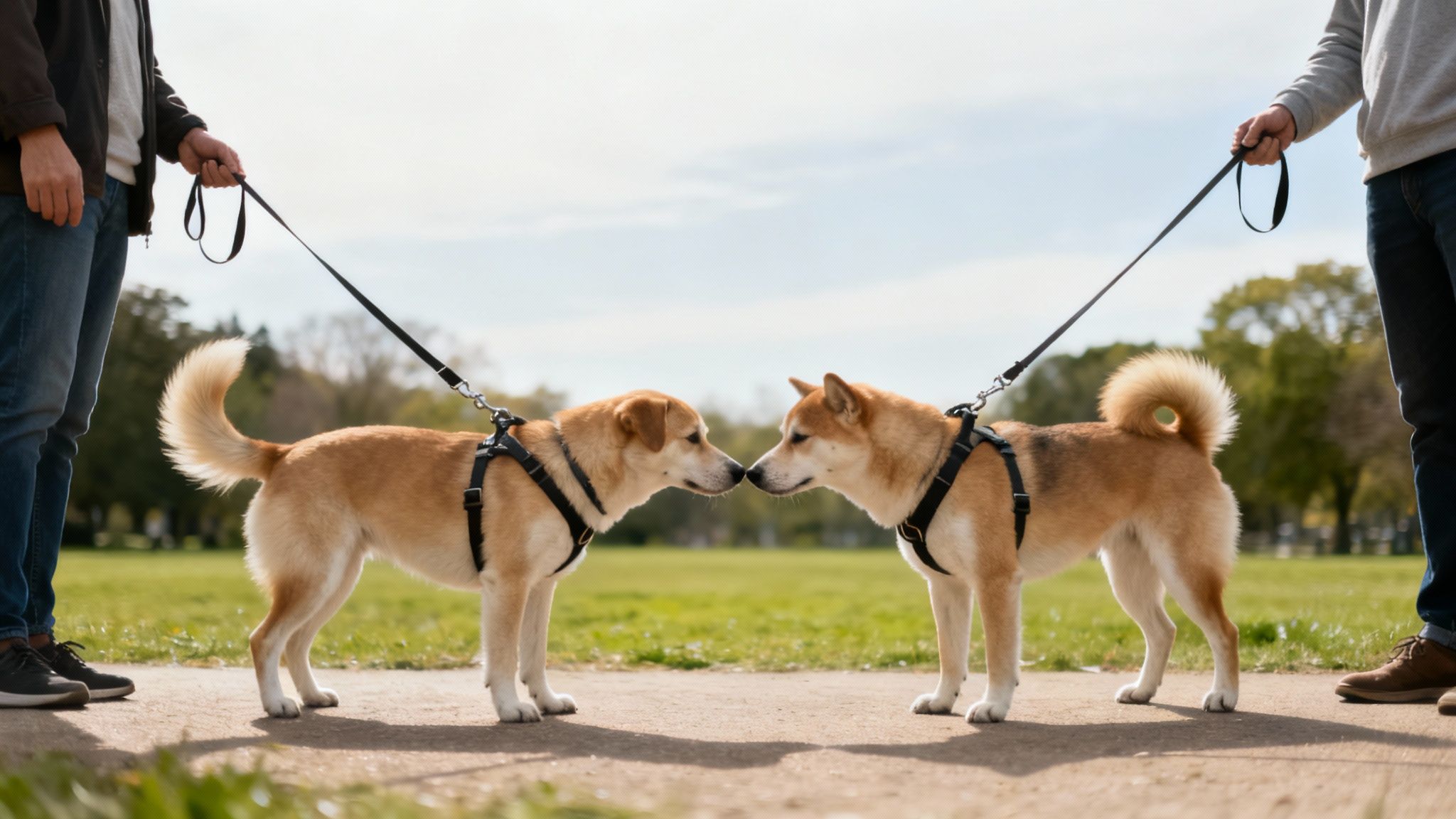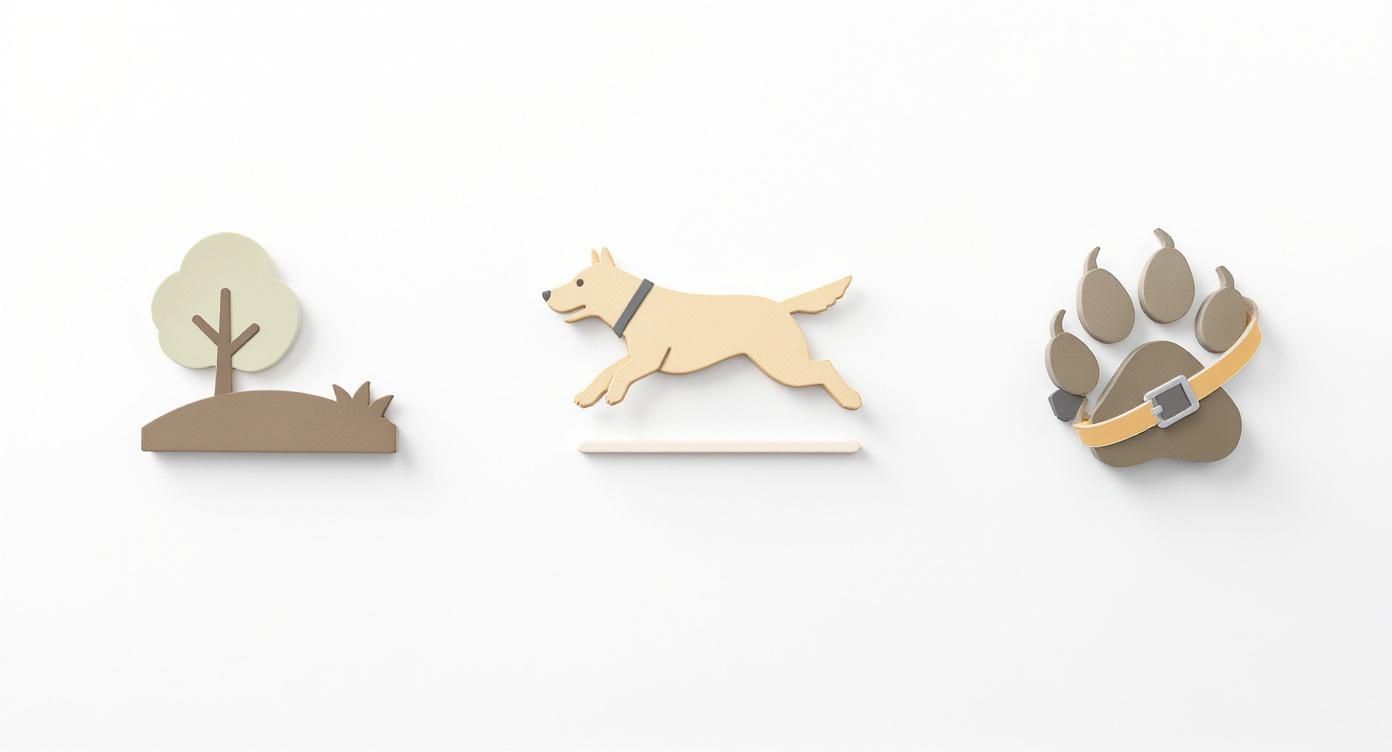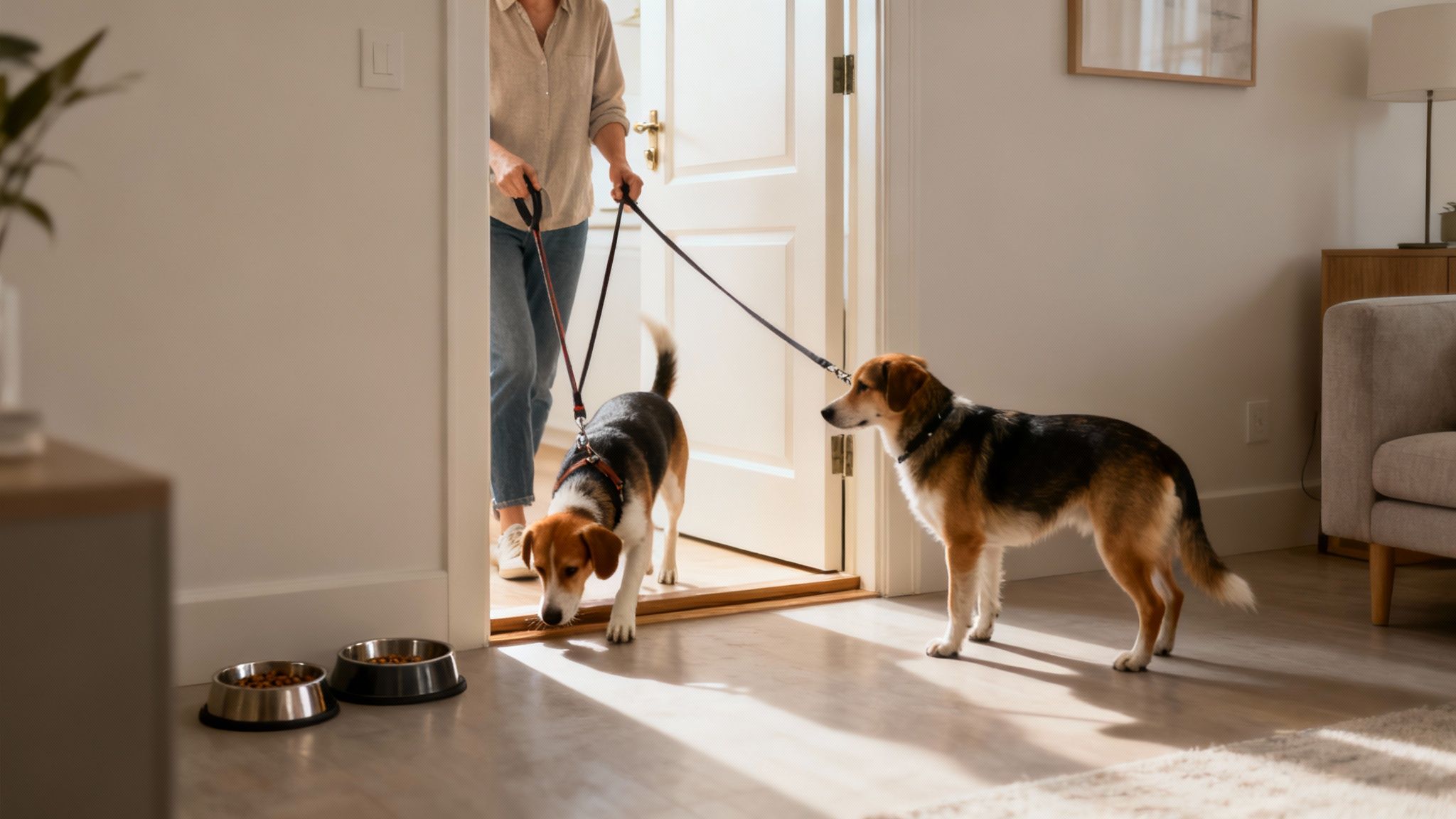We know the feeling. You're about to bring a new furry friend home, and all you want is for them to get along with your current dog. The key to a beautiful friendship is simple: we're aiming for a calm, positive first impression. The best way we can make that happen is by starting in a completely neutral space.
Let's begin with a parallel walk. This clever technique lets the dogs see and get used to each other's presence from a safe distance before we even think about a proper sniff. It’s a gentle, controlled approach that dials down the stress and helps prevent any territorial instincts from kicking in.
Creating a Positive First Impression

Bringing a new dog into your family is incredibly exciting, but let's be honest, it can be a bit nerve-wracking too. You just want them to be happy together, and that all starts with the very first meeting. Think of us as your guide on this journey to a successful, low-stress introduction.
Our entire focus here is on building trust right from that first sniff. Together, we'll look at why meeting on neutral ground is so important and how a simple parallel walk can work wonders for both of your dogs.
Knowing what to look for in their behaviour is also vital. Learning to decode dog body language is your superpower here. It'll help you spot the calm, happy signals in both dogs, making sure everyone feels safe and comfortable from the get-go.
Preparing for a Successful Meeting
Long before your dogs ever lay eyes on each other, the real work begins with you. Getting this part right sets the stage for a calm, controlled first meeting. It really comes down to three things we can prepare: location, energy, and equipment.
First up, let’s talk territory. Choosing a neutral space—like a quiet park or even a friend's garden—is absolutely critical. Why? Because it stops a dog's natural instinct to guard their home turf from creating tension before they've even said hello. It puts both dogs on an even playing field, which is exactly what we want.
Next, think about their energy levels. A bit of a 'pre-meeting workout' can be a genuine game-changer. Taking each dog for a brisk walk or a good game of fetch beforehand helps burn off all that excess energy. You'll find they're much more relaxed and receptive when the big moment arrives.
Finally, having the right gear is non-negotiable for everyone's safety. A secure harness and a standard, fixed-length lead give you far better control than a simple collar or a retractable lead. If you're not feeling totally confident with your lead handling, our complete overview of leash training for dogs is packed with tips to get you prepared.
Guiding The First Introduction
Right, this is the moment we've been preparing for, and you've got this. The key to a successful first meeting is for us to manage the entire interaction carefully. Forget those risky, face-to-face greetings you sometimes see. We're going to start with a parallel walk instead.
Picture this: you and the other handler are walking the dogs on opposite sides of a quiet street, both heading in the same direction. This simple setup allows them to see and smell each other from a safe, non-confrontational distance, which really helps to dial down any initial tension or excitement.
By starting on neutral ground, making sure both dogs have had some exercise, and having the right equipment, we're creating the perfect foundation for a calm meeting.
As you notice them start to relax—maybe their tails loosen up, or they stop pulling to get a closer look—you can gradually decrease the distance between you. Having the right gear is vital here; using a good quality lead gives you better control and more confidence. If you're unsure what to look for, this guide to training leads for dogs is a great resource.
When the time feels right, we'll use the 'three-second rule' for the first sniff.
Allow a brief, polite sniff (literally count to three in your head), then cheerfully call your dog away and carry on walking. This brilliant little trick prevents that intense, hard staring that can quickly escalate into a conflict. It keeps the whole experience positive, light, and moving forward.
Even when you’ve done everything by the book, introducing dogs can still have its tricky moments. But please don't panic. A growl isn't a disaster; it’s just your dog communicating with you.
Hearing one simply means it’s time for us to calmly create a bit more space between them. Let the dogs decompress for a few minutes before you even think about trying again. It's all part of the process, and it's okay.
Recognising and managing different personalities is also a massive part of the puzzle. If you have a boisterous, bouncy dog meeting a shy, reserved one, you’ll need to be their advocate and keep the interactions extra short. This stops the shy dog from getting overwhelmed and, just as importantly, teaches the bouncy one that calm behaviour gets rewarded. Every dog is an individual, especially rescues who might have an unknown history, so your patience really is everything.
City Living and Unique Hurdles
Trying to introduce dogs in urban areas throws up its own set of distinct challenges. Finding a truly neutral space can feel impossible, and the higher density of dogs can ramp up the tension before you've even started. In fact, it's thought that up to 30% of introductions can escalate without a properly safe meeting area.
If you find yourself struggling with reactivity or fear-based behaviours, our guide on managing aggressive dogs offers more specialised advice.
While our focus here is on setting you up for a safe and happy introduction, it’s always wise to be aware of the potential risks. For anyone wanting to be fully prepared, understanding dog bite injury legal aspects provides some valuable context on what can happen when things unfortunately go wrong.
Bringing a New Friendship Home
So, the outdoor meeting was a success? Fantastic! Now comes the next big milestone: translating that positive vibe into your home. This is where things can get a bit tricky, and the transition needs just as much care and thought from you to make sure both dogs continue to feel secure.
The main goal here is to make your home feel like neutral ground, at least for a while, even though it’s your resident dog's turf.
Before you even think about walking through the door, it’s a brilliant idea for you to do a quick ‘dog-proofing’ sweep of the house.
Prepare Your Home
We always recommend temporarily removing any high-value items that could spark a bit of possessive behaviour. We're talking about things like:
- Favourite Toys: Especially the squeaky ones or that grubby, well-loved chew toy.
- Food Bowls: These are a classic source of tension. Let's just pop them away for now.
- Special Beds: If your current dog has a cherished spot, it's best to remove it for the initial indoor meeting.
This simple bit of housekeeping helps prevent what's known as resource guarding and keeps things peaceful right from the very start. It’s a small effort for a huge payoff in their relationship.
When you’re ready, bring both dogs inside on their leads and keep a close, loving eye on how they manage the space.
Got Questions About Introducing Dogs? We’ve Got Answers.
We’ve walked through the step-by-step of how to introduce dogs, but it’s only natural for a few more questions to be buzzing around your head. Every dog and every situation is unique, so let's tackle some of the most common queries we hear from loving owners like you.
How Long Should That First Meeting Last?
This is a big one, and the answer is refreshingly simple: keep it short and sweet. The whole point is to finish on a positive, calm note before either dog gets tired, overwhelmed, or a bit cranky. We want them to have a good memory of this.
From the start of the parallel walk to that final brief sniff, the entire first meeting really shouldn't last more than 10-15 minutes. Think of it as leaving them wanting more. It sets a brilliant foundation for their next get-together.
What If My Dogs Just Don't Get Along?
It’s a worry every dog owner has, and we understand that completely. But it’s crucial to remember that not all dogs will be instant best mates, and that’s perfectly alright. Your initial goal isn’t a perfect friendship; it’s peaceful coexistence.
If you’re seeing persistent signs of stress, tension, or a clear dislike for each other, please don't try to force it. The best thing you can do is give them a break for a few days before trying another slow, careful reintroduction. For any ongoing issues, calling in a professional dog behaviourist is always the wisest and safest path forward for you and your dogs.
Can I Introduce a Puppy to an Older Dog?
Absolutely, but you’ll need to step up and be an extra-vigilant manager for them. An older dog often has very little patience for a puppy’s endless energy and needle-sharp teeth.
You can follow the exact same principles of a calm, neutral introduction, but keep the interactions incredibly short. Make sure your senior dog has a safe, puppy-free zone they can retreat to whenever they’ve had enough. Always supervise them to ensure the little one isn’t pestering the older dog. It really is all about respecting your older dog's boundaries and peace.
At K9 Time, we understand that every dog is an individual. If you need personalised support or a reliable dog walker in Sheffield to help manage your dogs' exercise routines, visit us at https://k9time.co.uk to learn more about our one-to-one services.

